Todai-ji is a UNESCO World Heritage Site. Also known as the “Great Eastern Temple”, it is the face and greatest landmark of Nara. It is not a stretch to say that all travellers that visit Nara will drop by here. Near Nara Park, deer gather at its front entrance.
Table of Contents
All About Todai-ji

History
Todai-ji is an ancient temple having started construction in 738 and opened to the public in 752. It was commissioned by Emperor Shomu with the purpose of being the Head Temple for all Buddhist temples around Japan in a network system called “Kokubun-Ji”. At present, it is the Head Temple for the Kegon Sect. It is also known as “Great Eastern Temple” due to its location on the east side of the Imperial Palace.
Todai-ji’s symbol of worship is the temple’s Great Buddha, also known as Nara Daibutsu. This large bronze Buddha statue is one of the biggest in Japan measuring at 15 meters tall and weighing 500 tons. As a comparison, the Kamakura Buddha is 13.35 meters tall and 121 tons heavy. It is kept inside the Daibutsu-den aka Great Buddha Hall.
The temple and the Buddha statue have suffered great destruction in the past. The entire complex originally consisted of 16 city blocks but was destroyed during the Genpei War as punishment for their involvement. Although the temple was reconstructed, at great expense, it still did not reach its original size. In the case of the Daibutsu, it used to be covered in gold. Moreover, it has gone through damage and restoration several times from earthquakes and fire, the worst being when the Buddha head fell off during an earthquake in 885.
※ World History Encyclopedia, "Todai-ji" ※ Todai-ji, “The Todai-ji”
The Temple's Great Influence
After the temple’s opening as the Buddhist Head Temple, it’s influence grew rapidly and vastly, so much so that it started to be involved in political affairs. This was a factor for the change of capital from Nara to Nagaoka - to reduce the temple’s influence and involvement in governmental affairs.
Recognized as a UNESCO World Heritage Site
In December 1998, Todai-ji was recognized as a UNESCO World Heritage Site alongside 6 other areas:
-
Kofuku-Ji Temple
-
Yakushi-Ji Temple
-
Toshodai-Ji
-
Gango-Ji Temple
-
Kasuga Taisha & Kasugayama Primeval Forest
-
Former site of Imperial Palace in Heijokyo
These 7 parts of Nara are recognized collectively as the Historic Monuments of Ancient Nara.
※ UNESCO World Heritage Centre, "Historic Monuments of Ancient Nara"
Writer's Pick
Closer Look at Todai-ji
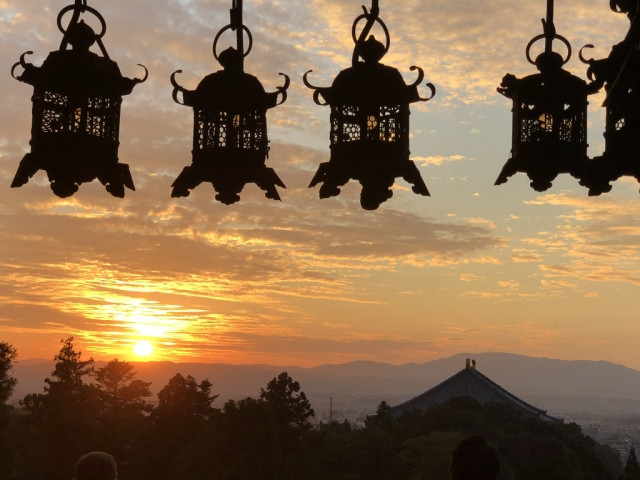
Highlights of Todai-ji
Todai-ji is undoubtedly a must-visit in Nara. We’ve even covered it in our Nara Article here:
What to do in Nara, the First Permanent Capital in Japan
Daibutsu-den 大仏殿
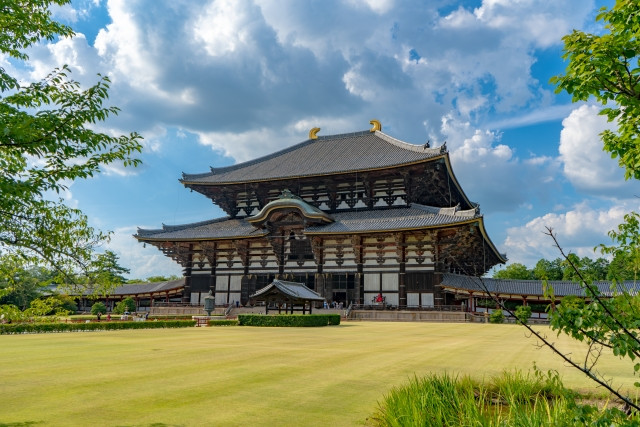
The Great Buddha Hall is the main hall of Todai-ji. It is one of the largest wooden buildings in the world measuring at 47 meters tall. Inside is the great bronze Nara Buddha statue.
The building has burnt down twice since it was first built and reconstructed during the Kamakura and Edo periods. In front of the hall is an octagonal stone lantern that has stood here since the temple was first built. On New Year’s Eve and New Year Day, the karahafu (gable) window is opened allowing visitors to see the Buddha from outside.
Entrance Fee: 600 yen (Adult)
※ Todai-ji, "The Great Buddha Hall"
Nandai-mon 南大門
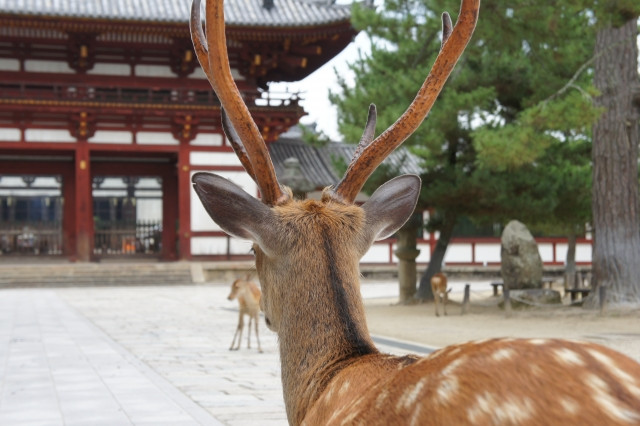
Also known as the “Great South Gate”, is a wooden gate that began construction in 1199 and completed in 1203. The greatest charm of this area is the wandering shika (deer) from nearby Nara Park. You can interact with them and feed them shika senbei (deer crackers) for 200 yen.
Kongo Rikishi 金剛力士
A pair of guardian statues situated in the Great South Gate. Also known as Ni-o 仁王 or "Two Kings of Todai-ji", namely Misshaku Kongo and Naraen Kongo. They are said to guard and protect the temple from evil spirits and demons.
※ Todai-ji, "Great South Gate"
Nigatsu-do 二月堂
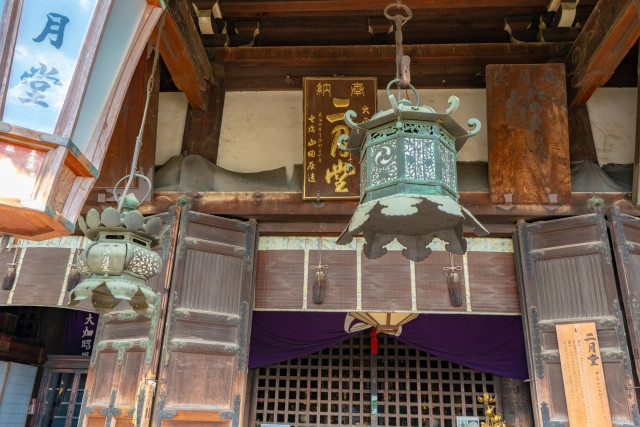
This sub-complex temple of Todai-ji is also known as “Second Month Hall”. It’s name is derived from the fact that Shuni-e is celebrated in February of the lunar calendar.
What is Shuni-e 修二会?
An annual Buddhist Temple ceremony for prayers and repentance. In Nara, it is celebrated through Omizutori お水取り meaning “water drawing”.
Fire torches are lit at Nigatsu-do when the ceremony begins. Monks draw water from a magical well that only contains water on this day. After offering the water to the Gods, it is offered to the temple visitors. It is said that the water has special purifying and healing powers.
Todai-ji’s Nigatsu-do’s Shuni-e is one of the most spectacular in Japan.
※ The Todai-ji, “Nigatsu-do”
Hokke-do 法華堂
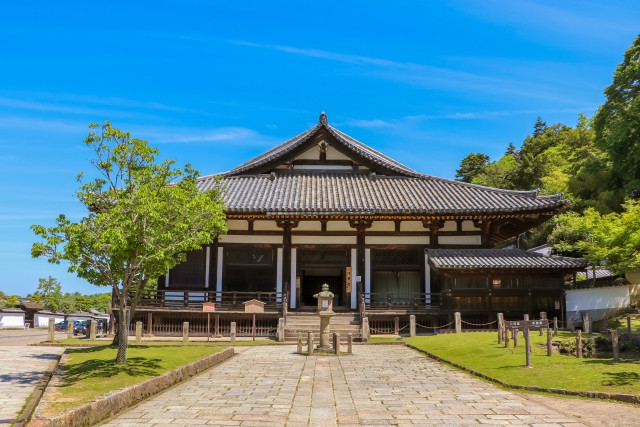
Also known as Sangatsu-do 三月堂, as in “Third Month Hall” for similar reasons to Nigatsu-do - the Lotus Sutra Recitation Ceremony is celebrated in March every year. It is the oldest building in Todai-ji having been in existence before Todai-ji was established. Its main figure is the standing Fukukensaku Kannon who is surrounded by ten other statues that encapsulate Nara Period’s art.
Entrance Fee: 600 yen (Adult)
※ Todai-ji, "Hokke-dō"
Kaidan-do
Located on the western side of the Great Buddha Hall. It houses the statues of Shitennoji, also known as the Four Heavenly Kings. The 4 statues are National Treasures of Japan.
Entrance Fee: 600 yen (Adult)
※ Starting 1 July 2021, works for preservation, repairs, and earthquake protection will take place for 3 years. Throughout this duration, the Four Heavenly Kings statues are available for viewing in Todai-ji Museum. Additionally, the usually closed to public Kaidan-in 戒壇院 will be specially opened for viewing.
※ Todai-ji, "Kaidan-in” “Kaidan-do”
Shosoin Repository
It is the only surviving storehouse from the Nara Period. Inside Shosoin are important artifacts including Empress Komyo’s offering to Buddha for the late Emperor Shomu, and 1,200 years old preserved medicines.
※ Imperial Household Agency, "History of The Shosoin"
Todai-ji Museum, Only 5-mins Away
Near Nandai-mon and Daibutsu-den is Todai-ji Museum. It contains all the treasures of Todai-ji, such as various calligraphy works, paintings, crafts, and other such artwork showcasing the temple’s important history.
Entrance Fee: 600 yen (Adult)
TIP
Save 200 yen. Get the joint pass covering Daibutsu-den and Museum for 1,000 yen (Adult).
※ Todai-ji Cultural Center, "History and Art of Todai-ji Temple Exhibition" ※ The Todai-ji, "Tōdai-ji Museum"
Access, Opening Hours, Ticket Information

Nearest Stations
The best way to get to Todai-ji is by bus:
-
From JR or Kintetsu Line’s Nara Station, take the city loop-line bus to Daibutsu-den Kasuga Taisha-mae Bus Station or Himuro Shrine/National Museum. The temple is 5-mins walk from either bus station.
-
From Kintetsu Nara Station, take the city loop-line bus heading to Oomiya-dori /Nara Park, then get off at Daibutsu-den-mae Parking Lot.
※ Todai-ji, "Public Transportation Information"
Opening Hours
The opening hours differ for warm and cold seasons as follows:
April to October
Daibutsu-den: 7:30am to 5:30pm
Todai-ji Museum: 9:30am to 5:30pm (Last Admission at 5pm)
November to March
Daibutsu-den: 8am to 5pm
Todai-ji Museum: 9:30am to 5pm (Last Admission at 4:30pm)
Year Round
Hokke-do & Kaidan-In: 8:30am to 4pm
Entrance Fees
Exploring the temple grounds is free of charge. Entrance fees are only applicable for visiting the temple structures and museum at 600 yen (Adult) per temple structure. Save 200 yen by getting a set ticket for Daibutsu-den and Todai-ji Museum for 1,000 yen (Adult).
※ Todai-ji, "Visiting Information"
Takeaway
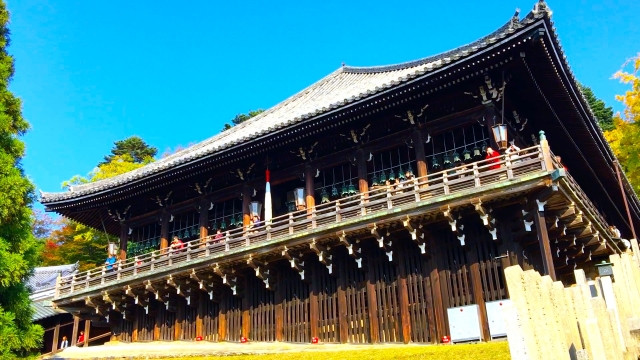
Todai-ji is a must visit when exploring Nara. Explore the history of ancient Nara, once the capital of Japan. Admire the giant Buddha statue, one of the biggest in Japan and even bigger than the Kamakura Buddha. Pat lovely deer near Nandai-mon and feed them crackers. Check out the Museum for more in-depth information on Nara and the temple’s history. And just overall enjoy the ambience of this peaceful religious place.
For more things to do in Home of the Deer Nara, check our article:
What to do in Nara, the First Permanent Capital in Japan







 (2).png)






















